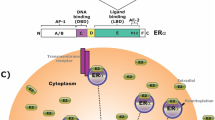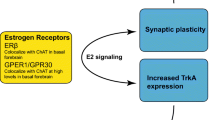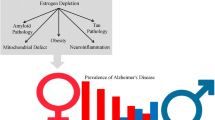Abstract
Within the last few years, there has been a growing interest in the neuroprotective effects of estrogen and the possible beneficial effects of estrogen in neurodegenerative diseases such as stroke, Alzheimer’s disease, and Parkinson’s disease. The concept of neuroprotective effects of estrogen in women remains controversial because these effects may vary with the timing of treatment. Research increasingly suggests that changes in estrogen levels during aging may increase risk for Alzheimer’s disease, the most common type of dementia. This update reviews the newest information about estrogen and cognitive aging, including information regarding the role of bioavailable estrogen in older women and men.

Similar content being viewed by others
References
Aliev G, Smith MA, Seyidov D, Neal ML, Lamb BT, Nunomura A, Gasimov EK, Vinters HV, Perry G, LaManna JC, Friedland RP (2002) The role of oxidative stress in the pathophysiology of cerebrovascular lesions in Alzheimer’s disease. Brain Pathol 12:21–35
Borras C, Gambini J, Gomez-Cabrera MC, Sastre J, Pallardo FV, Mann GE, Vina J (2005) 17beta-oestradiol up-regulates longevity-related, antioxidant enzyme expression via the ERK1 and ERK2 (MAPK)/NFkappa B cascade. Aging Cell 4:113–118
Cardona-Gomez GP, Mendez P, DonCarlos LL, Azcoitia I, Garcia-Segura LM (2001) Interactions of estrogens and insulin-like growth factor-I in the brain: implications for neuroprotection. Brain Res Rev 37:320–334
Dhandapani KM, Brann DW (2002) Protective effects of estrogen and selective estrogen receptor modulators in the brain. Biol Reprod 67(5):1379–1385
Diaz-Brinton R, Chen S, Montoya M, Hseih D, Minaya J, Kim J, Chu HP (2000) The Women’s Health Initiative estrogen replacement therapy is neurotrophic and neuroprotective. Neurobiol Aging 21:475–496
Dubal DB, Kashon ML, Pettigrew LC, Ren JM, Finklestein SP, Rau SW, Wise PM (1998) Estradiol protects against ischemic injury. J Cereb Blood Flow Metab 18:1253–1258
Fuh J-L, Wang S-J, Lee S-J (2006) A longitudinal study of cognition change during early menopausal transition in a rural community. Maturitas 53:447–453
Ganfornina MD, Do Carmo S, Martinez E, Tolivia J, Navarro A, Rassart E, Sanchez D (2010) Apo D, a glia-derived apolipoprotein, is required for peripheral nerve functional integrity and a timely response to injury. Glia 58:1320–1334
Gibson GE, Sheu KF, Blass JP (1998) Abnormalities of mitochondrial enzymes in Alzheimer disease. J Neural Transm 105:855–870
Henderson VW (2008) Cognitive changes after menopause: influence of estrogen. Clin Obstet Gynecol 51(3):618–626
Henderson VW, Sherwin BB (2007) Surgical versus natural menopause: cognitive issues. Menopause 14:572–579
Hosli E, Jurasin K, Ruhl W, Luthy R, Hosli L (2001) Colocalization of androgen, estrogen, and cholinergic receptors on cultured astrocytes of rat central nervous system. Int J Dev Neurosci 19:11–19
Janicki SC, Schupf N (2010) Hormonal influences on cognition and risk for Alzheimer’s disease. Curr Neurol Neurosci Rep 10(5):359–366
Kang JH, Weuve J, Grodstein F (2004) Postmenopausal hormone therapy and risk of cognitive decline in community-dwelling aging women. Neurology 63:101–107
Kok HS, Kuh D, Cooper R et al (2006) Cognitive function across the life course and the menopausal transition in a British birth cohort. Menopause 13:19–27
Kuroki Y, Fukushima K, Kanda Y, Mizuno K, Watanabe Y (2000) Neuroprotection by estrogen via extracellular signal-regulated kinase against quinolinic acid-induced cell death in the rat hippocampus. Eur J Neurosci 13:472–476
Lelu K, Laffont S, Delpy L, Polet PE, Perinat T, Tschanz SA, Pelletier L, Engelhardt B, Guéry JC (2011) Estrogen receptor a signaling in T lymphocytes is required for estradiol-mediated inhibition of Th1 and Th17 cell differentiation and protection against experimental autoimmune encephalomyelitis. J Immunol 187:2386–2393
Mattson MP, Robinson N, Guo Q (1997) Estrogens stabilize mitochondrial function and protect neural cells against the pro-apoptotic action of mutant presenilin-1. Neuroreport 8:3817–3821
McCarthy MM (2009) The two faces of estradiol: effects on the developing brain. Neuroscientist 15(6):599–610
Moosmann B, Behl C (1999) The antioxidant neuroprotective effect of estrogens and phenolic compounds are independent from their estrogenic properties. Proc Natl Acad Sci U S A 96:8867–8872
Nilsen J, Brinton RD (2004) Mitochondria as therapeutic targets of estrogen action in the central nervous system. Curr Drug Targets CNS Neurol Disord 3:297–313
Pérez C, Navarro A, Martínez E, Ordóñez C, Del Valle E, Tolivia J (2012) Age-related changes of apolipoprotein D expression in female rat central nervous system with chronic estradiol treatment. Age (Dordr). doi:10.1007/s11357-011-9286-5
Rocca WA, Grossardt BR, Shusterd LT (2010) Oophorectomy, menopause, estrogen, and cognitive aging: the timing hypothesis. Neurodegener Dis 7(1–3):163–166
Schumacher M, Akwa Y, Guennoun R, Robert F, Labombarda F, Desarnaud F, Robel P, De N, Baulieu EE (2000) Steroid synthesis and metabolism in the nervous system: trophic and protective effects. J Neurocytol 29:307–326
Shaywitz SE, Shaywitz BA, Pugh KR (1999) Effect of estrogen on brain activation patterns in postmenopausal women during working memory tasks. JAMA 281:1197–1202
Shughrue PJ (2004) Estrogen attenuates the MPTP-induced loss of dopamine neurons from the mouse SNc despite a lack of estrogen receptors (ER alpha and ER beta). Exp Neurol 190:468–477
Simpkins JW, Rajakumar G, Zhang YQ, Simpkins CE, Greenwald D, Yu CJ, Bodor N, Day AL (1997) Estrogens may reduce mortality and ischemic damage caused by middle cerebral artery occlusion in the female rat. J Neurosurg 87:724–730
Simpkins JW, Yi KD, Yang ShH, Dykens JA (2010) Mitochondrial mechanisms of estrogen neuroprotection. Biochim Biophys Acta 1800(10):1113–1120
Spampinato SF, Molinaro G, Merlo S, Iacovelli L, Caraci F (2012) Estrogen receptors and type-1 metabotropic glutamate receptors are interdependent in protecting cortical neurons against β-amyloid toxicity. Mol Pharmacol 81(1):12–20
Wang L, Andersson S, Warner M, Gustafsson JA (2001) Morphological abnormalities in the brains of estrogen receptor beta knockout mice. Proc Natl Acad Sci U S A 98:2792–2796
Zheng J, Ramirez VD (1999) Purification and identification of an estrogen binding protein from rat brain: oligomycin sensitivity-conferring protein (OSCP), a subunit of mitochondrial F0F1-ATP synthase/ATPase. J Steroid Biochem Mol Biol 68:65–75
Acknowledgments
This work is partly sponsored by a research project by the Serbian Ministry of Science, no. 175056.
Author information
Authors and Affiliations
Corresponding author
Rights and permissions
About this article
Cite this article
Petrovska, S., Dejanova, B. & Jurisic, V. Estrogens: mechanisms of neuroprotective effects. J Physiol Biochem 68, 455–460 (2012). https://doi.org/10.1007/s13105-012-0159-x
Received:
Accepted:
Published:
Issue Date:
DOI: https://doi.org/10.1007/s13105-012-0159-x




